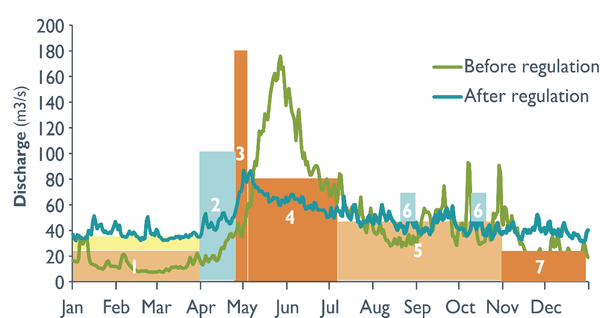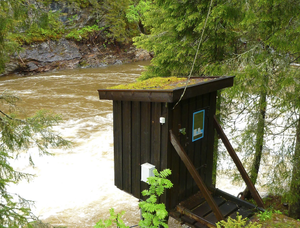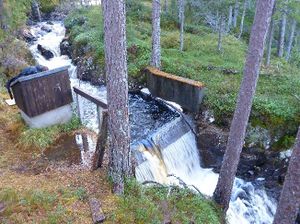Difference between revisions of "Mitigating reduced annual flow and low flow measures"
Bendikhansen (talk | contribs) |
Bendikhansen (talk | contribs) |
||
| Line 113: | Line 113: | ||
Hydropower operators must normally document that the environmental restrictions are followed, and would have standard monitoring systems (gauging stations) in place. | Hydropower operators must normally document that the environmental restrictions are followed, and would have standard monitoring systems (gauging stations) in place. | ||
| − | + | The effect of the released environmental flow must be done by assessing the development of the fish population, e.g. by monitoring juvenile fish densities, number of smolts, etc. | |
| − | + | [[file:gauge2.png|300px|Gauging stations monitoring water level and water flow (Photos: Knut Alfredsen).]] [[file:gauge1.jpg|300px|Gauging stations monitoring water level and water flow (Photos: Knut Alfredsen).]] | |
[[Category:Measures]][[category:Environmental flow in bypass section measures]] | [[Category:Measures]][[category:Environmental flow in bypass section measures]] | ||
Revision as of 14:09, 16 January 2019
Contents
Introduction
Bypass sections of a river regulation will typically experience dramatic reductions in total, annual flow, as large volumes of water are withdrawn for the purpose of producing electricity. The changes will depend on the hydrology characteristics, regulation capacity, the turbine characteristics (i.e. minimum and maximum capacities), the power production pattern and the minimum flow requirements. In cases with limited regulation capacities, spill of water will happen when the inflow is higher than the intake ponds can store and the turbines can utilise. How often this will happen is determined by the hydrological characteristics of the river.
The challenge related to reductions in total, annual flow would be to define ‘how much water is needed to sustain essential habitat qualities’, given dramatic reduced most of the time. This is the most common scientific task related to environmental flow assessments in bypass sections, and downstream the outlet of the hydropower plants in periods the hydropower plant is not in operation. A large set of approaches are available, spanning from simple statistical methods to comprehensive, holistic modelling approaches, with the aim of defining how much water should be released at what period of the year. The more simplified methods would require only a water flow timeseries, while the more advanced would needed detailed measurements of the topography and information about ecological preferences of various flow regimes.
Classification table
|
Assessment criteria |
Assessment |
|
Fish species measure designed for |
(All) Atlantic salmon (salmo salar) Trout (salmo trutta) |
|
Which life-stage of fish is measure aimed at? |
(All) Spawning / Recruitment Juvenile habitat (0+) Juvenile habitat (1+) Juvenile habitat (older than 1+) Adult fish Downstream migration Upstream migration |
|
Which physical parameter mitigated? |
Water velocity Water depth Water-covered area Water temperature |
|
Section in the regulated system measure designed for |
Bypass Downstream outlet (in periods the hydropower plant is not in operation) |
|
River type implemented in |
All |
|
Climatic region suitable for |
(All) A: Tropical (mega-thermal) climates B: Dry (arid and semiarid) climates C: Temperate (mesothermal) climates D: Continental (microthermal) climates E: Polar and alpine (montane) climates |
|
Level of certainty in effect |
Very certain (if no minimum flow from before) |
|
Technology readiness level (maturity) |
TRL 9 |
Methods, tools, and devices
During planning
The most common method to define environmental flow, or more correctly minimum flow, in Europe is to use of simple statistical criteria (Bakken et al., WFD-report). Q95 or variants of this is used in several countries as benchmark for the lowest flow releases in rivers with dramatically reduced flows. Q95 refers to the flow that during the natural conditions is exceeded in 95% of the time. Q95 is licence agreement defined as a constant flow that should be released throughout the year, or as a flow level defined based on natural flows during summer and winter, respectively, giving different static flow regimes summer and winter. Bakken et al. (2012) concluded in their review where the practice in a number of European countries were assessed, that the environmental flow requirements are typically in the range 5-10 % of mean annual flow. In some countries and in selected cases more advanced approaches are used, taking into account the natural variation in flow regime, and the varying flow requirements over the year. The building Block Method (BBM) (Tharme and King, XXXX) is one approach, while the environmental design concept (Forseth and Harby, 2014) has received very much positivism in Norway from both the hydropower industry, management authorities as well as various stakeholder groups. The Building Block Method intends to define flow regimes that are closer to the natural variation in water flow, i.e. mimicking natural floods, freshets and low flow periods. The environmental design concept aims at identifying the factors limiting the development of the fish population, which can be directly related to the flow regime, and then define the most efficient measures to the lowest cost. The environmental design concept also introduces the ‘water bank’ idea, where the water available for environmental purposes is released during the periods during the it is most needed. Hydraulic habitat modelling is a highly sophisticated approach that has been developed since the 1980’s, where the PHABSIM was one of the first computer program for such analysis. Hydraulic habitat modelling has been used in several cases where more detailed studies are required before the water flow regime can be defined, in addition to a large range of purely scientific studies. Hydraulic habitat modelling aims at identifying flows where the habitat conditions are suitable, based on various groups of species’ preferences for hydraulic variable such as water velocity, water depth and substrate conditions. This would sometimes reveal that increasing water flow will not always increase the areas of suitable habitat. Such studies have been carried out mostly related to defining suitable conditions for fish, but is in some cases also applied for benthic invertebrates. Hydraulic habitat modelling would require a 2- or 3-dimensional hydraulic model taking flow as input, and a set of ranges where water velocities, depths and substrate conditions are suitable. Casimir is such a tool that is developed in Germany, but applied in several rivers across Europe, as well as outside Europe. Hydraulic habitat modelling must be considered an ecosystem-based analysis, in contrast to the much simpler statistical approaches, such as applying Q95.
During implementation
If properly designed gates and vales are in place, the introduction of a new flow regime would simply be to release the defined water flows at the right time of the day and year. If the existing infrastructure cannot release the proposed flow regime, re-building of the dam or any other location the water should be released from, must be carried out.
During operation
Hydropower operators must normally document that the environmental restrictions are followed, and would have standard monitoring systems (gauging stations) in place.
The effect of the released environmental flow must be done by assessing the development of the fish population, e.g. by monitoring juvenile fish densities, number of smolts, etc.



